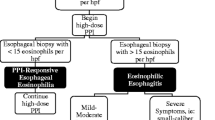Abstract
Background
Eosinophilic esophagitis (EoE) is an allergen-mediated, clinicopathological condition affecting all ages. The characteristics of children with EoE in the southwestern USA have not been fully described. Furthermore, very little is known about the relationship between parental allergies and risk of EoE in their offspring in this patient population.
Aims
To characterize children with EoE and to examine the relationship between prevalence of parental allergies and occurrence of EoE in their offspring at a single referral pediatric center in the southwestern USA.
Methods
Demographic and clinical information of 126 children (≤18 years of age) with EoE was abstracted in a pre-determined data extraction form and analyzed. The allergy history was collected from biological parents of 61 children (parent–child cluster) with EoE in a standardized questionnaire and analyzed.
Results
The median age at presentation was 8 years (interquartile range 4–13). The majority of our patients were male (71 %) and Caucasian (59 %). Overall, 84 % of children reported allergies. Prevalence of food allergy was significantly higher compared to environmental allergies (P = 0.001). At least 46 % of parents reported allergies. A significantly higher proportion of fathers had developed allergies during their childhood compared to adulthood (P = 0.03).
Conclusions
The characteristics of EoE in our patients were similar to those reported from other parts of the country. Childhood onset of paternal allergies appears to be a risk factor for occurrence of EoE in their offspring. Additional research to elucidate the relationship between parental allergies and occurrence of EoE in their offspring is warranted.


Similar content being viewed by others
References
Liacouras CA, Furuta GT, Hirano I, et al. Eosinophilic esophagitis: updated consensus recommendations for children and adults. J Allergy Clin Immunol. 2011;128:3e6–20e6. (quiz 21–22).
Branum AM, Lukacs SL. Food Allergy Among U.S. Children: Trends in Prevalence and Hospitalizations. NCHS Data Brief. 2008:1–8.
Rothenberg ME. Molecular, genetic, and cellular bases for treating eosinophilic esophagitis. Gastroenterology. 2015;148:1143–1157.
Dellon ES, Jensen ET, Martin CF, Shaheen NJ, Kappelman MD. Prevalence of eosinophilic esophagitis in the United States. Clin Gastroenterol Hepatol. 2014;12:589e1–596e1.
Chadha SN, Wang L, Correa H, Moulton D, Hummell DS. Pediatric eosinophilic esophagitis: the Vanderbilt experience. Ann Allergy Asthma Immunol. 2014;113:445–451.
Spergel JM, Book WM, Mays E, et al. Variation in prevalence, diagnostic criteria, and initial management options for eosinophilic gastrointestinal diseases in the United States. J Pediatric Gastroenterol Nutr. 2011;52:300–306.
Jackson KD, Howie LD, Akinbami LJ. Trends in Allergic Conditions Among Children: United States, 1997–2011. NCHS Data Brief. 2013:1–8.
Murdock SH, Cline M, Zey M. The Children of the Southwest: Demographic and socioeconomic characteristics impacting the future of the Southwest and the United States. In: Big ideas: Children in the Southwest. Washington, DC: First Focus; 2012:11–29.
Sperry SL, Woosley JT, Shaheen NJ, Dellon ES. Influence of race and gender on the presentation of eosinophilic esophagitis. Am J Gastroenterol. 2012;107:215–221.
Spergel JM. Eosinophilic esophagitis in adults and children: evidence for a food allergy component in many patients. Curr Opin Allergy Clin Immunol. 2007;7:274–278.
Wechsler JB, Bryce PJ. Allergic mechanisms in eosinophilic esophagitis. Gastroenterol Clin N Am. 2014;43:281–296.
Arshad SH, Karmaus W, Raza A, et al. The effect of parental allergy on childhood allergic diseases depends on the sex of the child. J Allergy Clin Immunol. 2012;130:427e6–434e6.
Philpott H, Nandurkar S, Royce SG, Thien F, Gibson PR. Risk factors for eosinophilic esophagitis. Clin Exp Allergy. 2014;44:1012–1019.
Acknowledgments
G.H. is supported by NIH T32-DK007664. Support from Digestive Diseases Research Core Center Program (P30 DK56338) is acknowledged.
Author information
Authors and Affiliations
Corresponding author
Ethics declarations
Conflict of interest
Authors declare no conflict of interest.
Electronic supplementary material
Below is the link to the electronic supplementary material.
Rights and permissions
About this article
Cite this article
Hiremath, G., Byramji, D., Pacheco, A. et al. Eosinophilic Esophagitis in Children and Its Relationship with Parental Allergies: Texas Children’s Hospital Experience. Dig Dis Sci 61, 501–506 (2016). https://doi.org/10.1007/s10620-015-3903-6
Received:
Accepted:
Published:
Issue Date:
DOI: https://doi.org/10.1007/s10620-015-3903-6




